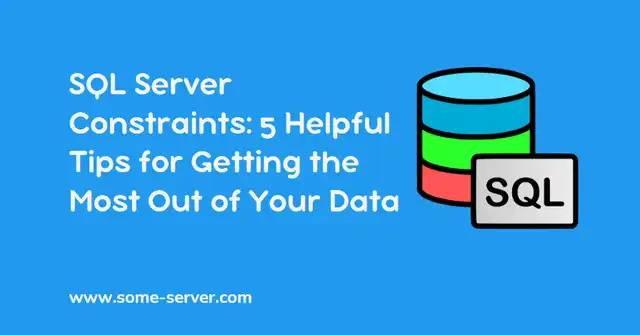Welcome to the SQL Server Constraints blog! This blog is dedicated to tips and advice for getting the most out of your data. Whether you’re a new user coming to SQL Server for the first time, or an experienced database administrator looking for ways to optimize your deployment, we hope you find the information here useful.
SQL Server constraints can be incredibly helpful in optimizing your data warehouse. In this blog post, we’ll explore constraints, how they work, and some of their benefits. We’ll also show you how to create constraints in SQL Server and how to use them throughout your data warehouse pipelines. Finally, we’ll provide tips on How To Use SQL Server Constraints so that you get the most out of these powerful tools!
What are SQL Server Constraints?
SQL Server Constraints are a powerful tool that you can use to optimize the performance of your SQL queries. They allow you to manage data integrity and keep your database stable. This article will provide helpful tips for getting the most out of your SQL constraints.
What Are SQL Server Constraints?
SQL Server constraints are a type of lockdown rule that allows you to control how data is used in a query by restricting what values can be queried or stored in specific columns or tables.
You can create constraints on any column within a table and on combinations of columns within a table.
When working with constrained selections, it’s important to remember that not all columns in every table are constrainable—only those explicitly specified using the CONSTRAINT statement syntax (or through an ALTER TABLE statement), like so:
SELECT id FROM Person; This would return only one row because no constraint is defined on the “id” column.
The following SELECT statements would each return two rows because different restrictions have been placed on the “id” column: SELECT id FROM Person WHERE name LIKE ‘%Andy’; SELECT id FROM Person WHERE last_name=’John’; To put it simply, restrictions placed on fields using CONSTRAINT clauses force rows from corresponding tables into certain predefined output fields when executing complex queries against these tables.
The benefits of using SQL server constraints include improving query performance and managing data integrity.
What are the benefits of using SQL Server Constraints?
SQL Server Constraints provide several benefits that can improve the quality of your data, prevent data inconsistencies, and reduce the time spent on data management tasks.
- First, SQL Server Constraints can help to prevent data inconsistencies by enforcing constraints on columns and rows.
This ensures that all values in a column or row are within specific bounds, which prevents incorrect or missing values from entering your database.
Additionally, constraints can be applied to individual fields or entire tables. As a result, you will have fewer opportunities for error when it comes to entering information into your database.
- Second, SQL Server Constraints can help to reduce the time spent on data management tasks by preventing inappropriate modifications to your database schema.
By using constraints, you can enforce standardization across multiple tables in your database and ensure that changes made to one table do not inadvertently impact other adjacent tables.
In addition, constraint definitions stored with schemas allow administrators to quickly determine if there is any potential conflict between different versions of an application’s schema while minimizing damages done during schema upgrades. Overall, using SQL Server Constraint.
How to create SQL Server Constraints?

You don’t need to be a data expert to use SQL Server Constraints. They are simple enough that even non-technical users can create constraints. And as you will see below, there are multiple purposes for which you can use them:
- Protect your data:When using restrictions, it is important to remember that they only apply while the constraint is active; once the constraint expires or is deleted, the data no longer meets the restriction and can continue flowing through your database without issue. This allows you to enforce specific rules on your data without affecting its functionality or availability during normal business operations.
- Improve performance:By constraining certain aspects of your database, you can optimize its performance by ensuring that all rows matching those constraints are processed instead of randomly accessed from the disk. This prevents contention and improves overall system throughput.
- Prevent data inconsistencies:Limiting how often different objects (like tables) can be updated simultaneously helps prevent incompatible changes from happening simultaneously, leading to less confusion and more consistent customer updates.
- Manage complexity: As databases become more complex with additional columns, triggers, functions, etc., managing these complexities becomes increasingly difficult – restricting access may help reduce this complexity.
- Speed up development time:Restrictions also speed up development times since developers do not have to research every possible scenario before building a solution.
How to use SQL Server Constraints?
SQL Server constraints can be used for many purposes, but we’ve selected three of the most common: optimizing your database, preventing data loss, and improving performance.
Optimizing Your Database: SQL Server constraints can help you to optimize the structure and design of your tables by specifying how data should be stored.
For example, specify that a table should have a specific number of columns or that certain data types should always be stored in fixed-length formats.
You can also use constraints to prevent duplicate records from being created or to enforce rules about how column values must be formatted.
Preventing Data Loss: Constraints can also help protect your databases from accidental deletion or corruption by enforcing formatting requirements or limiting the number of rows affected by an update operation.
In addition, they can prevent unauthorized users from viewing sensitive information by restricting access to particular tables or views.
Improving Performance: SQL Server constraints are often used as performance-tuning tools because they allow you to restrict the amount of time spent executing various queries within a database server.
By taking advantage of these benefits, you can improve overall system performance while ensuring that your data is safe and reliable.
Read Also: How to Create a Python Rest Server with Flask and Gunicorn (5 Best Way)
Conclusion
As you can see, SQL Server Constraints are a powerful tool that can help you manage and control your data more effectively.
By using constraints, you can ensure that your data is always accurate and up to date, making it easier for you to make decisions based on it. Thanks for reading!



